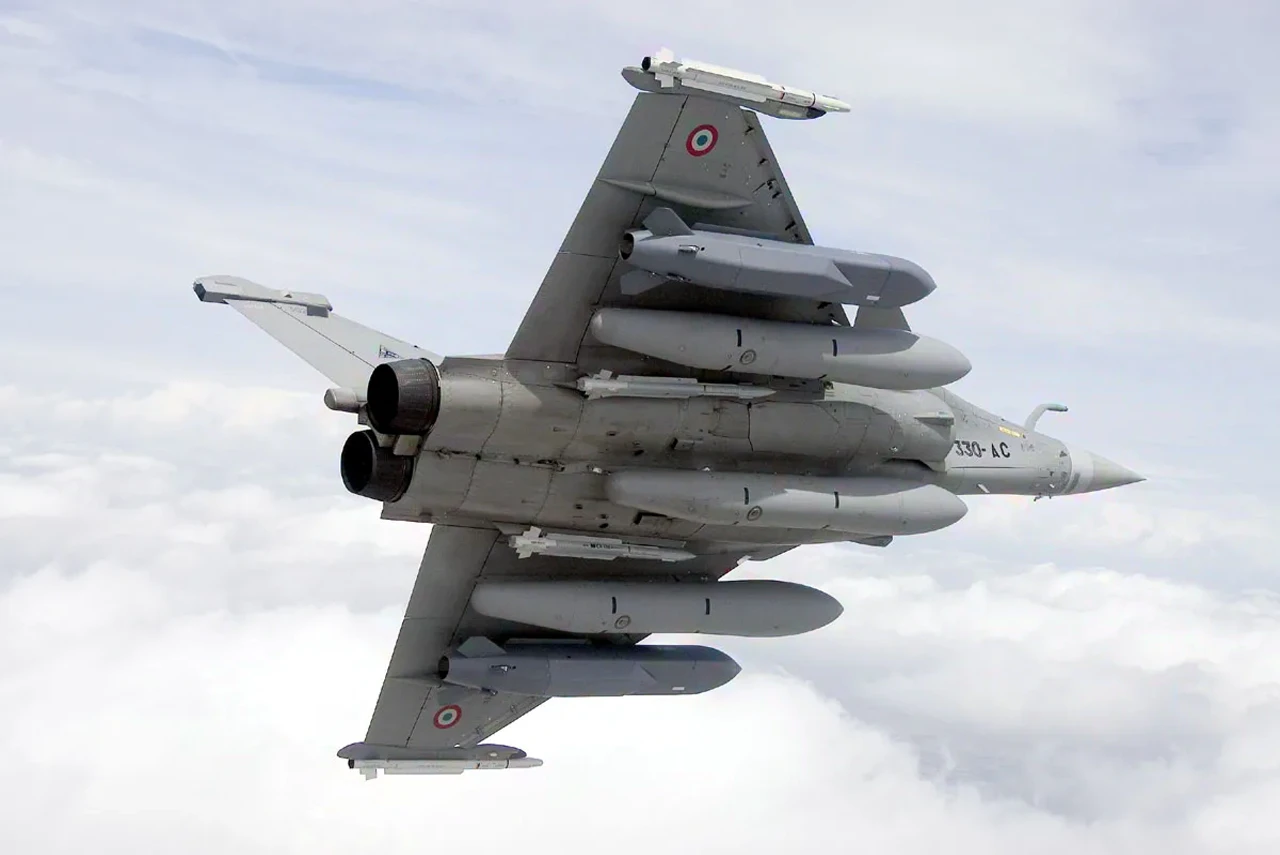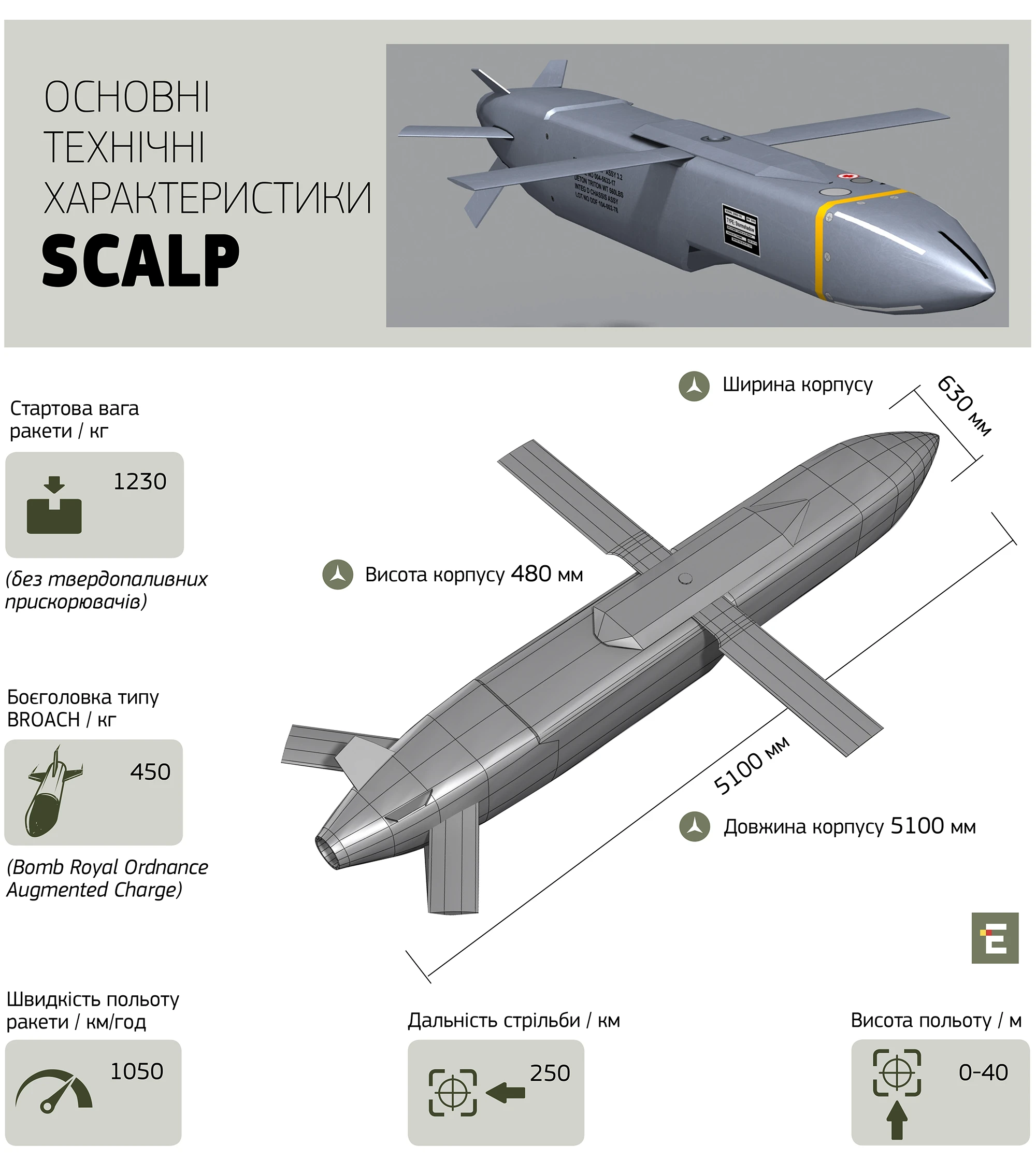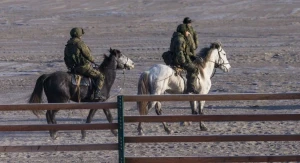
Long-range SCALP missiles overview: technical characteristics and usage
French President Emmanuel Macron announced at the NATO summit in Vilnius that the Ukrainian military will receive long-range missiles to counter the Russian invaders
Espreso tells about the SCALP missiles provided by France, their technical characteristics, cost and the potential targets.
What is a SCALP rocket?
A SCALP rocket is a type of missile that is launched from an aircraft and targets important stationary objects that are heavily protected by air defenses. It can be used in challenging weather conditions and at any time of the day. These missiles are not affected by the enemy's efforts to disrupt their guidance systems.

The missile's development started in 1995, and it underwent successful testing by the end of 2000. It was officially put into service in 2003.
Both the French and British versions of the missile are quite similar, with the main differences being in the software and the aircraft that carry the missiles.
The SCALP EG missile is similar to the British Storm Shadow missiles, with variations in software and the aircraft used to launch them. Storm Shadow missiles are already being used by the Armed Force of Ukraine. In May of this year, the United Kingdom announced that they would provide these missiles to Ukraine.
Technical characteristics
The export version of the missile can be launched from a distance of over 250 km, while the versions used by France and Britain can reach up to 560 km. It is unclear which version Ukraine will receive, but even the export version with a range of 290 km can hit targets in Russian-occupied territories.
SCALP missiles are more than 5 meters long with a body diameter of 63 cm. They weigh 1300 kg, and their payload is 450 kg, which enables them to create craters up to 30 meters deep.

These missiles are guided by a triple navigation system that combines inertial navigation, GPS, and terrain reference navigation. With the help of an infrared homing system and automatic recognition algorithms, they can effectively hit targets even in challenging conditions.
Specifications:
Firing range: 250 km or more.
Rocket speed: 1050 km/h.
Launch weight of the rocket (excluding solid fuel boosters): 1230 kg.
Body length: 5100 mm.
Body width: 630 mm.
Body height: 480 mm.
Warhead: 450 kg, known as BROACH (Bomb Royal Ordnance Augmented Charge).
Flight height: 0-40 m.
How the SCALP missile works
The Storm Shadow missile, which is similar to the SCALP, is considered an excellent modern cruise missile, according to Defense Express’ article. It has proven effective in overcoming strong air defenses in Syria, where both Syrian forces and Russian troops with S-400s, Pantsyr, and other defense systems tried to intercept the missiles.
“The Storm Shadow has specific features that make it successful. Firstly, it is designed to fly at low altitudes, typical for subsonic cruise missiles. Additionally, it incorporates stealth technologies to reduce the chances of detection. Secondly, it possesses an advanced guidance system that includes an inertial system, satellite navigation, and DSMAC, which allows the missile to scan the Earth's surface and compare it with a reference image,” the article reads.
To further minimize detection, the missile flies at an altitude of 100-150 meters throughout most of its trajectory and descends even lower when approaching the target.
The guidance system's key component is a thermal imaging head positioned beneath the fairing, which is released near the target area. This enables the missile to search for the stored target in its memory and direct itself towards it, rather than simply hitting predefined coordinates.
“The missile's warhead weighs 450 kilograms and employs a two-stage design called BROACH. In the initial stage, a shaped charge is detonated to penetrate the ground, reinforced concrete, or other obstacles. Subsequently, the main warhead enters through this hole to maximize its impact,” as explained by Defense Express.
Who used SCALP missiles and where
The British Air Force first used the missile during the Iraq War in 2003. In 2011, British, French, and Italian aircraft used Storm Shadow/SCALP missiles for airstrikes against the Gaddafi regime in Libya (around 15 missiles were used). The missiles were also used to target ISIS in 2015 and the chemical program of the Bashar al-Assad regime in Syria in 2018. During the missile strike on Damascus and Homs, allied forces launched 105 missiles, including at least 8 Storm Shadow and 9 SCALP missiles.
The Saudi Air Force used Storm Shadow missiles in military operations in Yemen. Currently, 9 countries use these missiles, including Ukraine, France, Britain, Italy, Greece, Egypt, Qatar, the UAE, and Saudi Arabia.
How SCALP will be used in Ukraine
The main task for the Ukrainian military is to adapt the French missiles to their aircraft. SCALP/Storm Shadow missiles are designed to be launched from Western-style combat aircraft like Tornado, Rafale, Mirage 2000, and Eurofighter. However, even before the Russian-Ukrainian war, Poland upgraded Su-24 bombers to accommodate these missiles. Ukraine has also modified Soviet-made aircraft to launch Storm Shadow missiles. Therefore, there shouldn't be any major issues with using the French missiles.
The primary targets for SCALP missiles will be crucial enemy locations such as command posts, air bases, fuel or ammunition depots, equipment storage facilities, and ships. The selection of targets will consider the practicality and cost-effectiveness of using the missiles.
The price of one missile ranges from 1.35 million to over 2 million euros. In 2011, the cost was approximately 850,000 euros, and an estimated price for export to Egypt in 2021 was 1.35 million euros. The current price according to the British press is 2 million pounds (2.3 million euros) per missile. Therefore, the use of SCALP missiles must be justified based on their cost.
The number of missiles being transferred to Ukraine has not been officially announced. Reuters, citing a French diplomatic source, claims that France will provide 50 SCALP missiles to Ukraine. Some missiles have reportedly already been delivered. According to French publication Le Monde, the French armed forces have 400 missiles of this type.
The limited number of missiles can be compensated by their effectiveness, which Defense Minister Oleksii Reznikov stated as 100% in May:
"I can say that all the Storm Shadow launches that have taken place so far have had a 100% success rate in hitting the targets designated by the General Staff. It is absolutely effective, 100 out of 100."
The Air Force of the Armed Forces also highly appreciates the capabilities of these missiles.
"If we have a sufficient number of missiles like SCALP, and possibly Taurus missiles in the future, which are also similar to Storm Shadow, we will be able to deliver more powerful strikes against the enemy. I hope that we will have more long-range, high-precision weapons, especially after the NATO summit in Vilnius," emphasized Yuriy Ihnat, the spokesman of the Air Force Command of the Ukrainian Armed Forces, on Espreso.
- News












































